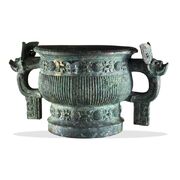
Bronze gui (Chinese, Zhou Dynasty, 1100-1000 BCE). It includes an inscription inside depicting conquest and success of the Zhou over the Shang Dynasty.
[]
A bronze gui was a ritual vessel used for the purpose of inscribing recorded events that could be relayed to Chinese ancestral spirits through food offerings. The practice began with the Shang Dynasty and was later adopted by the Zhou Dynasty . This particular vessel is from the Zhou period (1100-1000 BCE) in western China. The vessel's inscription tells of Kang Hou (King Wu's brother) and Mei Situ's success over the Shang and their resulting land allocations in Wei for their efforts to protect the Zhou.
Technical Evaluation
The Shang and Zhou Dynasties were responsible for the Chinese transformation from stone and iron use to a great deal of bronze use. Zhou artisans were able to create bronze ritual vessels like the one in the picture by creating an alloy of copper and zinc or also copper and lead. This alloy resulted in a bluish grey tint which can be seen in the image of the bronze gui. Bronze technology in ancient China was very advanced, especially for the Shang, as the first man-made alloy.
The process of creating bronze ritual vessels began with the labor intensive mining of the copper ore and zinc ore. Then the two ores were smelted together (alloying process). Next, ancient Chinese metallurgists created a mold of the vessel that could then be used to cast the piece. This process not only took high amounts of labor, but also took time and precision to successfully complete each vessel.
The bronze gui depicted in the image is located today in the Asia gallery of the British Museum .
Local Historical Context[]
The creation of the Kang Hou Gui took place during the conquest of the Zhou over remnants of the Shang. The vessel was created as a gift to record the event of Zhou leaders suppressing a Shang rebellion. The inscription inside gives tribute to the leaders and tells of the lands they acquired for their contributions.
The laborous and precise process needed to create the fine vessel gives the object its' great value. Only those within the elite and King Wu himself would have been able to afford such gifts. It was common during the early Zhou period for Kings to give out gifts to certain Zhou leaders as a way of requesting loyalty [See Khayutina 2010, 42]. These were the only people within Zhou society that could acquire the labor force and time needed to create such intricate ritual vessels. The vessel gave thanks to other Zhou leaders and showed signs of gratitude by honoring their ancestors.
The Zhou used bronze gui's for ritual practices where in they would place food inside the vessel to communicate important events and accounts of conquest to their ancestors.
World-Historical Significance[]
The main significance of the Kang Hou Gui and other similar ancient Chinese ritual vessels is the use of bronze. This time period marked the beginnings of bronze (first man-made alloy) use in China. This bronze technology eventually spread across the ancient world becoming popular among the elite of society.
Other than the vessel's technological achievements, the decoration and skilled artwork on the vessels made them renowned and made them considerably valuable/unique.
The ritual vessels really only have a major impact at the world level in modern day because their inscriptions help give an account of the major events and conquest of ancient Chinese dynasties.
Bibliography[]
Chao, Glenda. "bronze vessels: the nine tripods and materialized ideology," http://www.columbia.edu/~sf2220/TT2008/web-content/Pages/Glenda.html
Khayutina, Maria. 2010. "Royal Hospitality and Geopolitical Constitution of the Western Zhou Polity."T'oung Pao: Revue Internationale de Sinologie/International Journal of Chinese Studies 96, no. 1-3: 1-73. MLA International Bibliography, EBSCOhost (accessed April 21, 2011).
"Ancient Chinese Bronze," http://arts.cultural-china.com/en/30Arts2225.html
Britannica Online, "Chinese Bronzes." http://www.britannica.com/EBchecked/topic/1495894/Chinese-bronzes/283163/The-Zhou-dynasty-1046-256-bce
"Bronze (alloy)," http://www.britannica.com/EBchecked/topic/81000/bronze
"Chinese Zhou Ritual Vessel," http://www.britishmuseum.org/explore/highlights/highlight_objects/asia/b/bronze_gui_ritual_food_vessel.aspx
"Chinese Zhou Ritual Vessel," http://www.bbc.co.uk/ahistoryoftheworld/objects/9ncaOZABRHO5tcKeacBlJQ
"King Wu of Zhou," http://history.cultural-china.com/en/46History1570.html
"Metallurgists," http://www.calmis.ca.gov/file/occguide/metallur.htm
"The Shang Dynasty," http://library.thinkquest.org/12255/library/dynasty/shang.html
"Wei," http://www.britannica.com/EBchecked/topic/638861/Wei
"The Zhou Dynasty," http://library.thinkquest.org/12255/library/dynasty/zhou.html